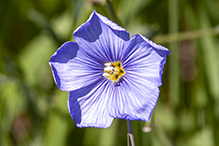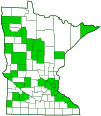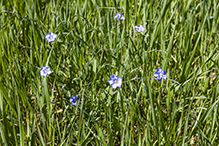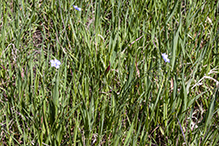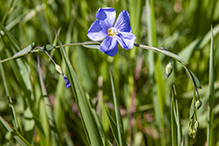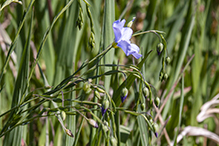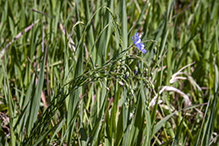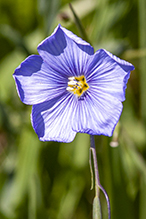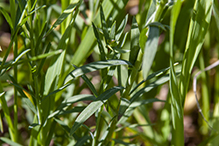Lewis flax
(Linum lewisii var. lewisii)
Conservation • Description • Habitat • Ecology • Use • Distribution • Taxonomy
Conservation Status |
|
|||||||
| IUCN Red List | not listed |
|||||||
| NatureServe | N4N5 - Apparently secure to Secure SNR - Unranked |
|||||||
| Minnesota | not listed |
|||||||
Description |
||
Lewis flax is an uncommon, non-native, prairie wildflower. It is native to western North America from Alaska to Mexico east to southwest Manitoba, North Dakota, and Texas. It is uncommon in Minnesota where it is considered adventive—it is not fully established and the populations in the state may not be self-sustaining. The first recorded observation in Minnesota was in 1959. It continues to spread as it is often included in seed mixes used on prairie restorations. Lewis flax is a 6″ to 31½″ (15 to 80 cm) tall, erect, perennial forb that rises usually on several stems from a branched woody base (caudex) and a deep taproot. It is found on prairies, meadows, roadsides, railroads, and disturbed sites. It grows under full sun in well-drained soil. It is intolerant of shade. It is semi-evergreen, with at least some foliage remaining green throughout the winter. The stems are usually erect or curve up from the base (ascending). In poor conditions they may recline on the ground. They are hairless, round in cross section, very leafy, and branched both near the base and in the inflorescence. The leaves are long, narrow, stalkless, alternate, and closely spaced, sometimes appearing whorled. The leaf blades are 3 ⁄16″ to 13 ⁄16″ (5 to 30 mm) long and 1 ⁄64″ to 3 ⁄16″ (0.5 to 4.5 mm) wide. They may be widest below the middle (lance-shaped), straight-sided and widest at the middle (linear), or widest above the middle (obovate). The base of the leaf does not continue down the stem. The upper and lower surfaces have neither hairs nor stalked glands. The margins are untoothed. Flowers are not produced until the third year or, if conditions are favorable, the end of the second year. The flowering period occurs from May to July and lasts about 33 days. The inflorescence is an open, one-sided, branched cluster (panicle) or unbranched cluster (raceme) of about 10 flowers at the end of the stem and branches. Each flower is on a 3 ⁄16″ to ¾″ (5 to 20 mm) long stalk (pedicel). The raceme or panicle branches and the pedicels droop when in bud, becoming more erect when in flower. The flowers are ¾″ to 1″ wide. There are 5 outer floral leaves (sepals), 5 petals, 5 stamens, and 5 styles. The sepals are green and ⅛″ to ¼″ (3.5 to 6 mm) long. The margins are dry, membranous, and untoothed. The petals are wedge-shaped to inversely egg-shaped and ½″ to ⅞″ long. They are usually bright blue, rarely white, with thin dark veins. The veins become darker and wider approaching the base. The base of the petals are white but sometimes appear yellow when covered with pollen. The petals open at sunrise and fall off by late afternoon. The stamens are ⅛″ to ⅜″ (3 to 10 mm) long and have white anthers. The styles are ¼″ to ½″ (6 to 12 mm) long and are free, not fused together. At the tip of the style the stigma is unlobed, globe-shaped, and abruptly expanded. The fruit is a globe-shaped to egg-shaped, ⅛″ to 5 ⁄16″ (4 to 8 mm) long, 3 ⁄16″ to ¼″ (5 to 6 mm) wide capsule. At maturity the capsule splits from the top down into 10 segments, each segment containing a single seed. The seeds are viscous or gelatinous when wet. |
||
Height |
||
6″ to 31½″ (15 to 80 cm) |
||
Flower Color |
||
Blue |
||
Similar Species |
||
Habitat |
||
Dry. Prairies, meadows, roadsides, railroads, and disturbed sites. Full sun. Well-drained soil. |
||
Ecology |
||
Flowering |
||
May to July |
||
Pests and Diseases |
||
|
||
Use |
||
|
||
Distribution |
||||
|
Sources |
|||
| 5/6/2023 | ||||
Nativity |
||||
Native to western North America, adventive and spreading in Minnesota |
||||
Occurrence |
||||
Uncommon in Minnesota |
||||
Taxonomy |
|||
| Kingdom | Plantae (green algae and land plants) | ||
| Subkingdom | Viridiplantae (green plants) | ||
| Infrakingdom | Streptophyta (land plants and green algae) | ||
| Superdivision | Embryophyta (land plants) | ||
| Division | Tracheophyta (vascular plants) | ||
| Subdivision | Spermatophytina (seed plants) | ||
| Class | Magnoliopsida (flowering plants) | ||
| Superorder | Rosanae | ||
Order |
Malpighiales (nances, willows, and allies) | ||
Family |
Linaceae (flax) | ||
| Subfamily | Linoideae | ||
| Genus | Linum (flaxes) | ||
| Species | Linum lewisii (prairie flax) | ||
There are three varieties of Lewis flax (Linum lewisii). The nominate variety L. l. var. lewisii is the most widespread and the only variety found in Minnesota. |
|||
Subordinate Taxa |
|||
|
|||
Synonyms |
|||
Adenolinum lewisii Linum perenne ssp. lewisii Linum perenne var. lewisii |
|||
Common Names |
|||
blue flax Lewis flax Lewis’ flax Lewis’s flax prairie flax wild blue flax |
|||
Glossary
Ascending
Growing upward at an angle or curving upward from the base.
Caudex
A short, thickened, woody, persistent enlargement of the stem, at or below ground level, used for water storage.
Linear
Long, straight, and narrow, with more or less parallel sides, like a blade of grass.
Panicle
A pyramidal inflorescence with a main stem and branches. Flowers on the lower, longer branches mature earlier than those on the shorter, upper ones.
Pedicel
On plants: the stalk of a single flower in a cluster of flowers. On insects: the second segment of the antennae. On Hymenoptera and Araneae: the narrow stalk connecting the thorax to the abdomen: the preferred term is petiole.
Raceme
An unbranched, elongated inflorescence with stalked flowers. The flowers mature from the bottom up.
Sepal
An outer floral leaf, usually green but sometimes colored, at the base of a flower.
Stigma
In plants, the portion of the female part of the flower that is receptive to pollen. In Lepidoptera, an area of specialized scent scales on the forewing of some skippers, hairstreaks, and moths. In Odonata, a thickened, dark or opaque cell near the tip of the wing on the leading edge.

Slideshows |
||

Visitor Videos |
|||
Share your video of this plant. |
|||
| This button not working for you? Simply email us at info@MinnesotaSeasons.com. Attach a video, a YouTube link, or a cloud storage link. |
|||
Other Videos |
|||

Visitor Sightings |
|||||
Report a sighting of this plant. |
|||||
| This button not working for you? Simply email us at info@MinnesotaSeasons.com. Be sure to include a location. |
|||||
|
|||||
MinnesotaSeasons.com Sightings |
|||||

Created: 12/23/2019
Last Updated:
